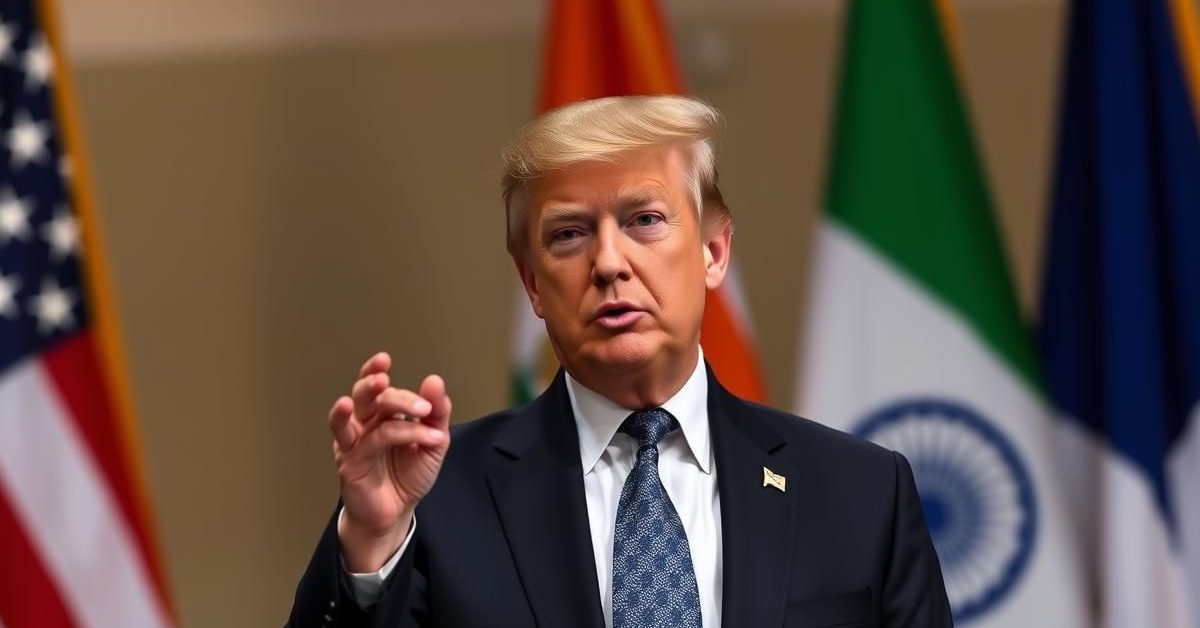US President Donald Trump announced that a trade deal with India is nearing completion, even as the US imposed significant new tariffs on 14 other nations, largely from the ASEAN region.
US-India Trade Deal: A Step Closer?
President Trump recently stated that the United States is “close to signing a trade deal” with India. This announcement comes amid ongoing negotiations between the two countries.
Reports suggest that Indian negotiators have offered considerable market access for US goods in various sectors. However, sensitive areas like dairy and agriculture remain excluded from these discussions.
In return, the US is expected to provide lower tariffs on Indian labor-intensive products. This includes key sectors such as textiles and footwear, which are crucial for India’s export economy.
Notably, India was not among the 14 countries initially targeted for new reciprocal tariffs by the US, a positive sign for the ongoing bilateral trade talks.
New Tariffs Target ASEAN and Beyond
While discussions with India progress, the US has unveiled new reciprocal tariffs ranging from 25 to 40 percent on 14 other nations. These countries include Bangladesh, Malaysia, Japan, Cambodia, and South Korea.
The Association of Southeast Asian Nations (ASEAN) appears to be a primary focus of these new measures. India’s Trade Minister, Piyush Goyal, previously referred to ASEAN as “China’s B team,” highlighting the region’s increasing economic ties with Beijing.
Six of the 14 targeted countries are ASEAN members. Laos and Myanmar face the highest tariffs at 40 percent. Thailand and Cambodia, which have seen significant Chinese investment and economic integration, were hit with 36 percent US tariffs. Indonesia, importing a third of its goods from China, received a 32 percent reciprocal tariff.
China is a major financier of Cambodia’s infrastructure and a strong supporter of its Belt and Road Initiative. Following previous trade disputes, China ramped up its engagement with ASEAN through investment and industrial integration, boosting manufacturing across the region.
Outside of ASEAN, Japan, South Korea, Malaysia, Kazakhstan, and Tunisia face 25 percent tariffs. South Africa and Bosnia & Herzegovina were hit with 30 percent duties, while Bangladesh and Serbia received 35 percent tariffs.
The Nature of Trump’s Trade “Agreements”
According to the New Delhi-based think tank Global Trade and Research Initiative (GTRI), these announced deals do not meet the standards for Free Trade Agreements (FTAs) under World Trade Organization (WTO) rules.
WTO FTAs require mutual tariff reductions on a substantial portion of trade. However, under the Trump model, only the partner country lowers its tariffs, while the US makes no reciprocal cuts.
The US is merely offering to roll back “Liberation Day” tariffs, which were imposed under emergency powers and have already been ruled unlawful by a US federal court. This legal challenge makes the basis of these “deals” fragile.
GTRI suggests that even if a deal is struck, Indian exports could still face a minimum 10 percent additional levy. This implies a pressured compromise rather than a genuine partnership. The think tank also raised concerns about Trump’s unpredictability, suggesting that even signed deals might be subject to change.
A Warning to BRICS Nations
Adding another layer of complexity, President Trump recently threatened an additional 10 percent tariff on BRICS countries, including Brazil, Russia, India, and China.
This warning came after the BRICS Summit in Rio, where members criticized US unilateral tariffs and explored alternatives to the US dollar, including a common trade currency. The expansion of the group to include Iran, Saudi Arabia, and the UAE has heightened Washington’s concerns about a shift in global trade leadership.
GTRI interprets Trump’s warning as a clear message: any country perceived as aligning with BRICS positions, or pursuing what he terms “anti-American” policies, could face new tariffs, regardless of prior agreements. For the US, it appears “loyalty trumps legality.”
- The US announced it is “close” to a trade deal with India, which was not among the nations targeted by new tariffs.
- New US tariffs of 25-40% were imposed on 14 countries, with a significant focus on ASEAN members.
- Experts suggest these “deals” are not standard WTO-compliant FTAs, as they lack reciprocal tariff cuts from the US.
- President Trump also threatened BRICS nations, including India, with new tariffs if they pursue “anti-American” policies or challenge the US dollar’s dominance.
The landscape of global trade continues to shift, with the US adopting a dynamic and sometimes unpredictable approach to its trade relationships worldwide.














